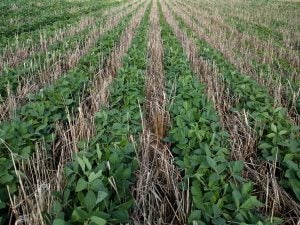The end of the growing season for cash crops doesn’t mean the end of the opportunity to build the productive capacity of your soil — and it’s something you should be thinking about at the end of harvest.
The underground herd of microorganisms that drives the majority of nutrient cycling and soil aggregate formation can continue to be fed, and actively building soil, as the traditional growing season comes to a close. In northern climates, the dates for the average last frost in the spring and the first frost in the fall should not define the time your soil can host living roots that feed soil biology. There are a number of plants (such as hardy annuals, winter annuals, hardy biennials, or perennials) that may be able to sustain a living root in the soil for an extended period of time into late fall or early winter, or perhaps all winter long.
The first thing that can be done to help improve your soil in the fall of the year is perhaps the easiest. Do nothing. Do not disturb the soil with tillage in order to manage crop residues. Tillage degrades soil aggregates and results in a loss of soil organic matter. Crop residues may be chopped or grazed to help them cycle faster if you anticipate that an excessive amount of residue might be an issue at planting time for the next crop.
Another approach to address copious amounts of crop residues is to plant a low carbon-to-nitrogen ratio cover crop (such as one that might include legumes and/or brassicas) that can feed the soil with a living root and then help the soil biology break down crop residues. When nitrogen is released from a decomposing cover crop in the spring, that nitrogen allows soil organisms to consume carbon-rich residues more quickly.
Including such a cover crop in your system requires some thoughtful planning. First and foremost one needs to determine the desired goal(s) the cover crop will serve. This will help determine the species that might be included in the mix. Then, one must consider the logistics of acquiring seed and getting it on the field at the point in time desired. Will the cover crop seed be applied prior to cash crop harvest, or immediately afterward, and how? Filling a gap in your cropping sequence with a cover crop is best planned a year or more in advance. While it might be too late to plant a cover crop this fall, it is the perfect time to plan to include one next time around.
It is also important to understand that most of the carbon that is retained in the soil as organic matter comes from sugars exuded by the root systems of plants while the plants are green and alive. The majority of the carbon contained in the crop residues left behind on the soil surface after harvest goes back into the air as carbon dioxide when soil organisms consume them and respire (breathe in oxygen and breathe out carbon dioxide) as they work to break those residues down. This does not mean that crop residues on the soil surface are wasted! There is no waste in nature.
Plant residues on the soil surface play an important role in protecting the soil from the impacts of rain and wind, reduce evaporation of water from the soil, catch and retain snow, and provide habitat for the organisms that live near the soil surface. However, it is living roots that feed the organisms below the soil surface that causes the most carbon to be retained in the soil and to develop the most stable soil aggregates. It is stable soil aggregates that help the soil take in water and allow for the exchange of gases with the atmosphere. This is how the combination of crop residues covering the soil and winter-hardy plants growing in the soil can both protect the soil from degradation and keep soil biology fed for an extended period of time.

Another very important “big picture” consideration for cropping sequences, as well as cover crops, is to maximize the diversity of plants grown in your system as much as possible. Many producers follow cropping sequences that include only a few species of plants. Adding a cover crop to the system can be an excellent opportunity to expose the community of organisms in the soil to several more species of plants they might not otherwise have an opportunity to be fed by. This type of biological priming can do wonders for nutrient cycling in the soil and possibly reduce the expense of supplemental nutrients from purchased fertilizer. Diversity of crops in a cropping sequence and diversity of species of plants in cover crops will also reduce pest pressure, conceivably reducing money spent for pest control measures.
Regardless of your location or cropping sequence, give some serious thought to the gaps of time when you currently do not have living roots in the soil. Consider filling those gaps with a new cash crop or cover crop in your overall cropping system plans. Oftentimes, the opportunity to add both diversity and living roots feeding the soil occurs during the fall and winter when cash crops are in the bin. This time of the year may also provide an opportunity to reflect on your entire cropping system and give you enough lead time to plan a change. Such a change could help build your soil’s capacity to help you produce more while spending less.
Jon Stika is a retired Natural Resources Conservation Service soil health instructor and current part-time professional at the North Dakota State University Dickinson Research Extension Center. He is also the author of “A Soil Owner’s Manual: How to Restore and Maintain Soil Health.”



